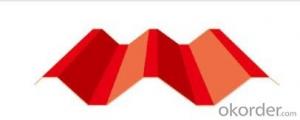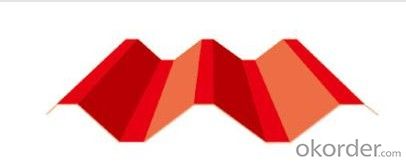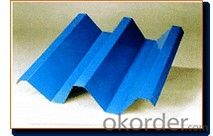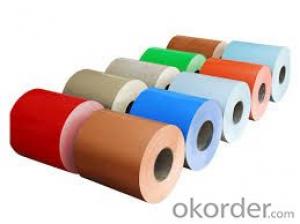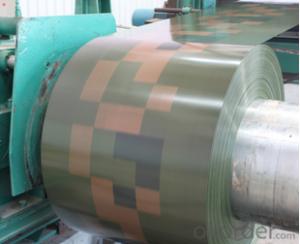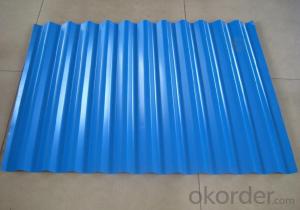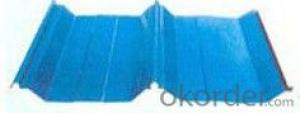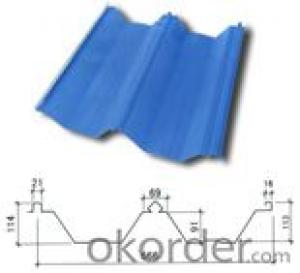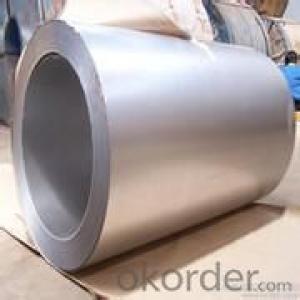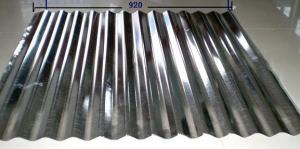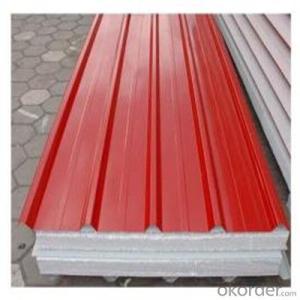EXCELLENT CORRUGATED STEEL SHEET RED-BLUE
- Loading Port:
- China Main Port
- Payment Terms:
- TT OR LC
- Min Order Qty:
- -
- Supply Capability:
- -
OKorder Service Pledge
OKorder Financial Service
You Might Also Like
EXCELLENT CORRUGATED STEEL SHEET RED-BLUE
Corrugated sheets are made from Galvanized steel coils, Galvalume Steel coils, Galvalume Pre-
painted sheet and aluminum sheet, prepainted hot dip galvanized steel coils, roll formed by roll forming machines, the thickness and color can be different.
Our products have significant advantages as below:
1)lower price and best quality
2)waterproof and fire insulation
3)light weight
4)fast and convenient istallation
5)different color
6)high strength
7)Durable
8)free of maintenance
9)beautiful appearance
The followings are the trade terms:
1)Package: 1 to 2 tons/package by kraft paper and wood pallet(packing size can be made as per your requirement as well)
2)Minimum Order Quantity: 1000 square meters
3)Delivery Time: 15 days upon down payment or LC
4)Payment terms: by TT or LC
Product Details:
Place of Origin | China (Mainland) |
Brand Name | CNBM |
Model Number | 900 |
Material | Color Steel |
Color | any color is available |
Payment & Shipping Terms:
Price: | FOB USD 2~5 / Meter |
Minimum Order Quantity: | Negotiable Trial Order |
Minimum Order Quantity: | 20 Ton/Tons 20 MTTrial Order |
Port: | XINGANG |
Packaging Details: | waterproof paper, steel strip, iron sheet, C chaneel |
Delivery Time: | 25 days after receiving deposit |
Payment Terms: | L/C,T/T |
Supply Ability: | 250000 Ton/Tons per Year 20 MT |
Roofing color corrugated steel sheet
1) Max. width: 600- 980mm
2) Thickness: 0.236-1.00mm(commonly 0.3-0.6mm)
3) Length:Less than 12m
Roofing color corrugated steel sheet
1. Base sheet: galvanized steel sheet
2. Standard: JIS, ASTM, GB
3. Thickness: 0.14mm—0.5mm
4. Width: 762mm, 914mm, 1000mm before corrugation
Raw material 762mm to 665 mm, 660mm(after corrugated) an d 9 waves
Raw material 914mm to 800mm, 810mm(after corrugated) and 11 waves
Raw material 1000mm to 875mm, 880mm, 890mm,900mm, 914mm(after corrugated) and 12 waves
5. Zinc: 60g--180g/m2
6. Color: All colors according to RAL color system
7. Package: covered by one layer of pvc film on the surface of steel sheet, or in bundle.
8. Features: light-weight, high-strength, erosion-resistant, quakeproof, easy-installation, colorful, anti-rust, long life, etc.
9. Application: steel structure workshop, sandwich panel workshop, transportation, outside decoration of various buildings, home appliances like refrigerator, air conditioner, electric cookware, etc
- Q: What are the different surface finishes for steel coils?
- There are several different surface finishes for steel coils, including hot rolled, cold rolled, galvanized, and coated finishes.
- Q: For some reason, if you rub iron oxide or lodestone (both very crumbly, dark, mineral-like materials) into soft, unhardened steel, their particles actually get stuck into the surface of the steel (that is, darkening it). My question is, how does this work? How come iron oxide and lodestone can get stuck, and how come other materials (like silicone carbide, for example) do not?My second question is, are there any materials that can get stuck into steel, that is also blue in color, and how would I best obtain it?
- Funny! 100!
- Q: how come when i put steel legs in lowest price in grand exchange no one buys them i got 101 steel legs in there and there at lowest price and they have been there for 3 days
- Becuase you should sell something else.
- Q: My company want to welding stainless steel, do not know to use what welding machine?
- There are many ways in welding stainless steel, such as coating manual welding,argon arc welding, pulsed argon arc welding, MIG, pulsed MIG, double pulsed MIG. Different welding ways own their merits and faults and adaptive working conditions. It is recommended to choose pulsed MIG, its molding very good and efficiency high, so it is mainstream application for stainless steel welding. Now many digital welding machines can supply these welding methods at the same time. And their welding effects is far better than traditional machines. Among them, FRONIUS’s TPS series and Nebula series are representitive products.
- Q: How are steel coils inspected for quality control?
- Steel coils are inspected for quality control through various methods. These methods include visual inspections, dimensional measurements, and non-destructive testing techniques such as ultrasonic testing or magnetic particle inspection. Additionally, the coils are checked for surface defects, such as scratches or corrosion, and are also examined for proper labeling and packaging to ensure they meet the required quality standards.
- Q: How are steel coils processed for edge trimming or slitting during processing?
- Steel coils are processed for edge trimming or slitting during processing by utilizing specialized machinery. The coils are unwound and fed into the machine, where the edges are trimmed off to achieve the desired width. For slitting, the coil is passed through multiple sets of circular blades that cut it into narrower strips. This process ensures precise dimensions and smooth edges, making the steel coils ready for further applications.
- Q: Can steel coils be used in architectural applications?
- Architectural applications can indeed utilize steel coils. These coils possess versatility and can be transformed into various shapes and forms to match the distinctive design specifications of architectural ventures. They find utility in constructing structures such as buildings, bridges, and more, as well as in fabricating architectural elements like roofing, cladding, and facades. The utilization of steel coils in architectural applications presents several benefits. They exhibit exceptional durability, strength, and corrosion resistance, rendering them suitable for constructing enduring and low-maintenance structures. Steel coils can be customized in terms of thickness, width, and surface finish, granting architects the ability to achieve their desired aesthetic and functional objectives. Moreover, steel coils are renowned for their structural stability and load-bearing capacity, both of which are vital considerations in architectural designs. Their high strength-to-weight ratio makes them an ideal selection for creating spacious and open interior areas, as well as for supporting heavy loads in multi-story buildings. Additionally, steel coils are easily fabricated and installed, resulting in time and labor savings during the construction process. They can be efficiently molded, cut, and welded to create intricate shapes or architectural details. Additionally, steel coils can be pre-fabricated off-site, guaranteeing precision and quality control, and subsequently assembled on-site, reducing construction time and minimizing disruptions to the surrounding environment. All in all, steel coils present architects and designers with a wide array of possibilities in architectural applications. Whether it pertains to structural support, aesthetic appeal, or functional requirements, steel coils provide a dependable and versatile material option that can fulfill the demands of contemporary architectural projects.
- Q: I know that steel is generally iron with carbon and probably some other things in it, but I'm doing a research paper on architecture in Tokyo, and touching on the Tokyo Tower.The Tokyo work is larger than the Eiffel Tower by 12 meters, but lighter by 3000 tons. The only reason I can find for the difference in weight is that the Tokyo Tower is made of steel and the Eiffel Tower in made of iron, and since the Tokyo Tower is modeled after the Eiffel, there's really not a substantial difference in the amount of metal used....
- For the same volume of part, like a cubic inch, the weight is very close. If you base the comparison on strength, like a bar strong enough to hold XXX pounds, then the forged bar will be lighter, smaller still hold the weight.
- Q: How are steel coils used in the production of electronic devices?
- Steel coils are used in the production of electronic devices in a variety of ways. One common use is in the manufacturing of transformers and inductors, which are crucial components in many electronic devices. Transformers and inductors consist of a coil of wire wound around a core, and steel coils are often used as the core material due to their magnetic properties. The steel coils used in these components help to enhance the magnetic fields generated by the coils, enabling efficient energy transfer and voltage regulation. The magnetic properties of steel, such as its high permeability and low hysteresis loss, make it an ideal material for these applications. Additionally, steel coils are also used in the production of printed circuit boards (PCBs). PCBs are the backbone of most electronic devices and consist of a flat board made of non-conductive material, such as fiberglass, with a thin layer of copper traces etched onto it. These copper traces form the electrical connections between various components on the board. Steel coils are used in the production of PCBs as part of the fabrication process. They are typically used to create the stencils that are used to apply solder paste onto the board before component placement. The steel coils are laser-cut to create precise stencil patterns, allowing for accurate and consistent solder paste application. In summary, steel coils play a vital role in the production of electronic devices. They are used in the manufacturing of transformers and inductors, where their magnetic properties enhance energy transfer and voltage regulation. Steel coils are also utilized in the fabrication of PCBs, where they are used to create stencils for solder paste application. Overall, the use of steel coils helps ensure the efficient and reliable operation of electronic devices.
- Q: How are steel coils used in the manufacturing of solar panels?
- Steel coils are used in the manufacturing of solar panels primarily for the structural support and durability they provide. These coils are often used to construct the frames and mounting systems that hold the solar panels in place. The strength of steel ensures that the panels remain stable and secure, even in harsh weather conditions. Additionally, steel coils can be shaped and formed to meet the specific design requirements of solar panel installations, making them a crucial component in the manufacturing process.
Send your message to us
EXCELLENT CORRUGATED STEEL SHEET RED-BLUE
- Loading Port:
- China Main Port
- Payment Terms:
- TT OR LC
- Min Order Qty:
- -
- Supply Capability:
- -
OKorder Service Pledge
OKorder Financial Service
Similar products
Hot products
Hot Searches
Related keywords
